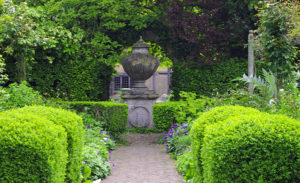The Lord Leycester Hospital is the wonderful timber frame building at the bottom of High Street by the original west gate into the city. Over the last 500 years, the building has begun to sag and has a definite lopsided look to it.
Warwick was originally a walled town with four gateways into the town. In 1126, Robert de Newburgh built a chapel over the West Gate which was used by travellers entering and leaving the town. Roger’s wife died young, so it became a chantry chapel with priests saying masses for the repose of her soul. The chapel is still in use today by the Brethren who attend a daily morning service. It is also popular for weddings, particularly at Bank Holiday weekends.
The Guild of St George was created under a license issued by Richard II in 1386 and Thomas Beauchamp rebuilt the chapel and granted it to the Guild. Subsequently, the Guild of the Blessed Virgin based at St Mary’s Church, joined them and living quarters were built for the resident priests along with meeting rooms and dining halls, the buildings that are seen today. They became known as the United Guilds of Warwick and were involved in education and charity work.
When the guilds were dispersed by Henry VIII, their master had transferred their property to the Burgesses of Warwick to stop it falling into the hands of the king. The Burgers used the Guildhall for their meetings and Warwick School used the rest of the buildings.
In 1571, Robert Dudley, Earl of Leicester acquired the buildings and was granted permission from Elizabeth I to turn them into a hospital to house aged or disabled soldiers and their wives. The Master, a clergyman, in charge of the 12 residents, lived in the Guild master’s house. The rest of the building was divided into living quarters for the Brethren. Their meals were provided by the kitchen beneath the stairs of the courtyard where the tea room is today.
The Brethren were clothed in the traditional uniform of a Tudor hat and black gown with the silver badge of the Bear with the Ragged Staff, the symbol of Robert Dudley. This uniform is still worn today on all formal occasions.
After Robert Dudley’s death, the hospital continued to be run under a charter laid down by him. The Hospital still provides homes for eight ex servicemen and their wives today. In the mid C20th this was replaced by a Board of Governors when the Hospital was refitted and modernised. The number of living quarters was reduced to eight. It is now run as a self supporting charity relying mainly on income from visitors.
Behind the sprawling frontage of the C14th timber frame is a central courtyard. The walls are decorated with the heraldic symbols of families linked to the Hospital, including the Bear and Ragged Staff emblem of the Earls of Warwick and the blue porcupine symbol of the Sidney family. Robert Dudley left no heir so the estate passed to his sister Mary, wife of Sir Henry Sidney of Penshurst in Kent and the mother of Sir Philip Sidney, soldier and poet.
A flight of star leads up to an arcaded gallery with the Guildhall on the first floor. Below was the brethren’s kitchen, now the tea room.
The Great Hall with its timber frame roof is on the left. This is used for functions.
The Chapel of St James over the West Gateway is reached up a flight of stone stairs. The original chapel dated from the C12th but was rebuilt in the C14th by Thomas Beauchamp, Earl of Warwick. Richard Neville, Warwick the Kingmaker added the tall square tower. It was extensively restored in the C19th by Sir George Gilbert Scott.
Inside, it is a simple rectangular structure with bare stone walls and a wood beamed roof. There is a very small nave area before the heavily carved rood screen leading into the chancel.
The pews have carved ends with either the Bear and the Ragged Staff or the Lion of Dudley.The back pews have lovely carved angels on the backs with carved figures of animals or people on the arms.
There is no electricity and the chapel is still lit by candles. The corona in front of the altar is a particularly fine example of medieval metal work.
The Chapel, Great Hall, Guildhall and “Master’s Garden”:http://wasleys.org.uk/eleanor/gardens/england/west_midlands/leycester/index.html are are open daily except on Mondays. The Regimental Museum of the Queen’s Own Hussars is closed on Saturdays. There are often weddings in the chapel on Bank holiday weekends. It is worth ringing before visiting to check that the Hospital is open. The Brethren’s Kitchen provides light meals as well as cakes and drinks.
Entry is £5.90 and the money is used to help fund the hospital and buildings. There is no parking by the Hospital but there are nearby car parks on Market Street and Linen Street.
There are more pictures “here.”:http://wasleys.org.uk/eleanor/presocialhistory/socialhistory/social/social/lord_leycester/index.html








